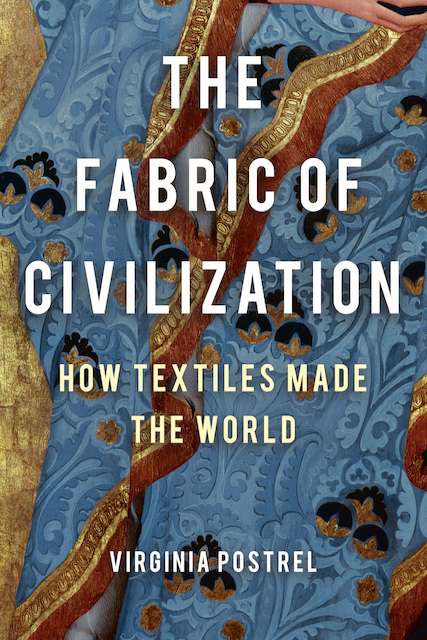The Volokh Conspiracy
Mostly law professors | Sometimes contrarian | Often libertarian | Always independent
When Cloth Was Money, Literally
Before industrial production, textiles could make excellent currency.
In pre-industrial economies, textiles have many of the characteristics essential to a good currency. They're durable, portable, and divisible. Bolts can be produced in standard sizes and uniform quality. The quantity is limited, since cloth takes a long time to produce and it flows out of the money supply as it's transferred to everyday use, thereby avoiding inflation.
We tend to think of money as something established by central authorities, and sometimes cloth currency was just that. (In The Fabric of Civilization I discuss how China's Tang dynasty, short on coins, defined silk bolts as legal tender.) But that need not be the case. Elsewhere in the world, textile money emerged out of commercial usage, supported but not created by law.
Set in the mid-eleventh century, the Icelandic tale of Audun begins in the early summer, when a Norwegian merchant name Thorir arrives on the island's northwestern Westfjords peninsula. Living in a land inhospitable to forests or farming, Icelanders relied on imports for timber and grain. They paid for these goods in the same currency they used locally: a woolen twill cloth called vaðmál (or wadmal). Thorir could sell his goods in Iceland and return with a ship laden with textiles. But there was a problem. The customers didn't have enough cash—vaðmál— on hand.
"If the Norwegian was to get paid for his flour and timber, the Icelandic buyer was unlikely to have enough cloth woven until later in the summer at best," explains William Ian Miller, a legal historian and Icelandic saga scholar. "The merchant would have to wait until you literally made your money to pay him and not infrequently the merchant had to stay the long winter to get his payment." Meanwhile, the grain might go bad.
Fortunately for Thorin, the story's Icelandic hero Audun identifies creditworthy customers. If Thorin gives them grain now, he can reliably expect cloth in time to set sail in the late summer. As a reward for his credit-reporting services, Audun gets passage on the ship, setting in motion the tale's events.
Iceland's vaðmál wasn't just a commodity. Woven to specific standards, it was a legally recognized medium of exchange and store of value, the primary form of money during Iceland's Commonwealth Period (930–1262 CE). As a unit of account, the third function of money, a piece of vaðmál two ells wide and six ells long (about a yard by three yards) was, writes anthropological archaeologist Michèle Hayeur Smith, "ubiquitous as a measure and medium of exchange in Icelandic legal texts, sales accounts, church inventories, and farm registers into the seventeenth century." (This image, from an Icelandic manuscript, depicts measuring out an ell of vaðmál.)
The archaeological evidence backs up the written records. Microscopically examining more than 1,300 archaeological textile fragments, Hayeur Smith found clear indications of cloth becoming money. The material from the Viking Age, before 1050, includes many different weave structures and widely varied thread counts. Medieval fragments, by contrast, are much more uniform—overwhelmingly the dense twills recognized as legal money. The analysis, she writes, reveals "such degrees of standardization and ubiquity that one can only conclude that cloth truly had become a unit of measure, a type of 'legal cloth currency' produced and circulated among households of all ranks across the island." In the Middle Ages, "Icelanders were weaving money in abundance."
In West Africa, too, merchants at least as far back as the 11th century used textiles to create the currency they needed to conduct trade. For many West African fabrics, narrow strips are sewn together to form a larger textile, which is worn as a single piece. (Kente cloth is one example.) Unlike colorful textiles for apparel, a strip intended as currency would be left undyed and wound into a tight, flat coil as it came off the loom. Merchants could roll such coils on the ground, sling them on either side of a pack animal, or carry them flat on the head with other goods added on top. Since weaving widths varied from place to place, if a market attracted more than one type, traders established a standard rate of exchange. A given strip length, usually that of a woman's wrapper, would be the primary monetary unit, with a full cloth forming a larger denomination.
Although African currency cloth functioned primarily as money, it did have a consumer market among the poor and desert dwellers to the north, who had no cotton. Going north, therefore, a unit of cloth bought more; going south, it bought less. Traders adjusted their travel expenditures accordingly. "A merchant from Upper Volta, for example, going to Timbuctu to buy salt with cloth produced in his home area, would use cloth to pay his way on the northward journey," writes historian Marion Johnson, "but on the return journey he would prefer to use salt which appreciated in value as it moved southward, even if he had first to sell it for local cloth money.
The same was true of silver and gold flowing from the Americas, where it bought less, to Europe and Asia, where it bought more. Cloth money was actually more self-regulating and less prone to shortages or inflation than metallic currencies. When its value rose, weavers would make more. If it became less valuable, consumers would take more. The result was a fairly constant value over time, set by the cloth's price as a commodity.
Money is a self-perpetuating social convention, a token that we trust will be valuable in future exchanges. If buyers and sellers, courts and tax authorities, accept textiles as payment, they are money.

Show Comments (78)